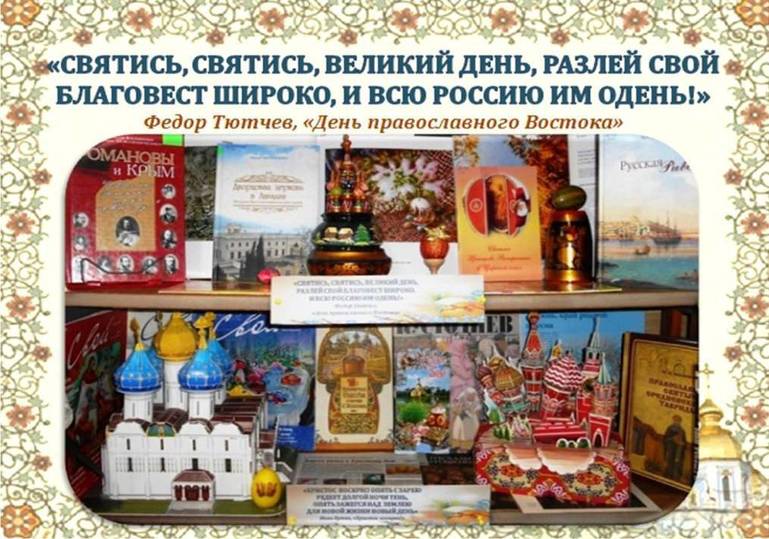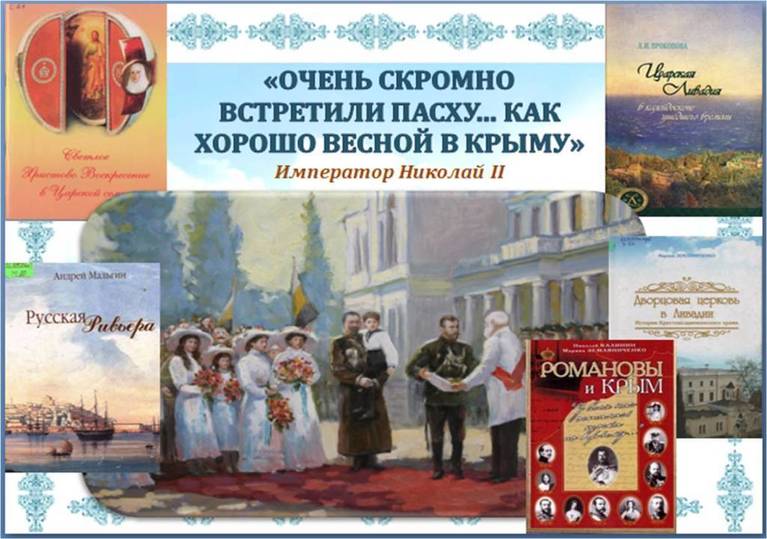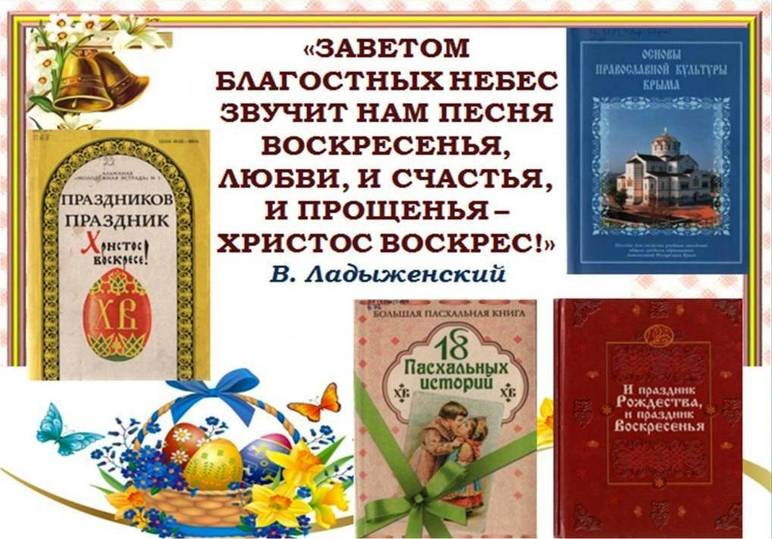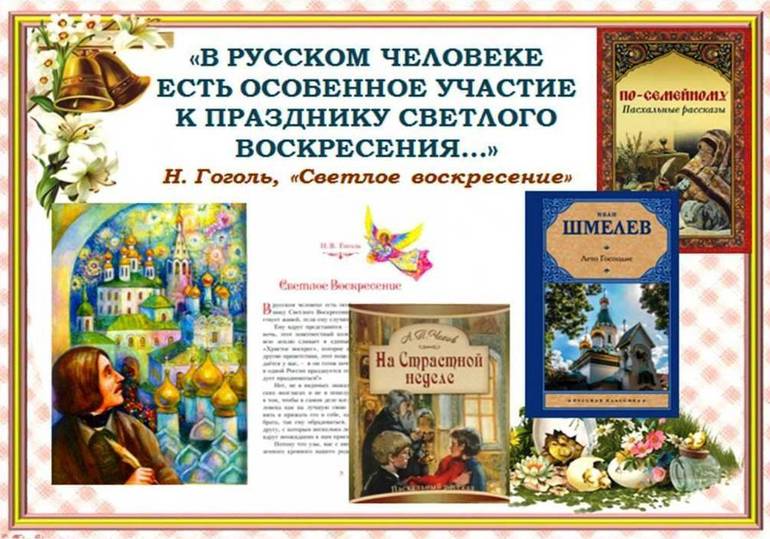On the day of the celebration of Bright Easter, the library-branch №4 named after M.M. The Kotsyuby Central Library for Adults in Simferopol has timed an exhibition-exposition “Russian churches of the Holy Annunciation”, the headings of which include poetic lines of Russian poets, emphasizing the importance of this bright holiday, giving faith and hope for a better future.
“Holy, holy, great day, spread your gospel widely, and clothe all of Russia with them!” – Fyodor Tyutchev enthusiastically wrote in his poem “The Day of the Orthodox East” about one of the most joyful and revered spring holidays in the Orthodox world – the Bright Resurrection of Christ, or Easter. For many centuries, this holiday that fills the soul with light and warmth has absorbed the most valuable concepts for the Slavic soul – peace and harmony, goodness and generosity of the soul, love and forgiveness.
“Christ is risen! Again with the dawn a long night glows a shadow, again a new day lit up over the earth for a new life “(I. Bunin),” Since ancient times, the prophet’s gospel over the Russian land in his voice spoke to us about heaven; So the sun ray of spring sometimes illuminated the path of nature to bloom “(K. Balmont),” In a foreign land I sacredly observe the native custom of antiquity: I release a bird into the wild at the bright holiday of spring “(A. Pushkin),” Everywhere the gospel is buzzing, people knocks down. Dawn is already looking from heaven … Christ is Risen! ” (A. Maikov).

“Fundamentals of the Orthodox culture of Crimea”, “Holidays holiday”, “18 Easter stories”, articles of “Crimean Izvestia”, magazines “Treasure Peninsula”, “Crimean magazine”, “Svoy”, other publications tell about the history, customs and traditions of celebrating Svetlaya Easter, including on the hospitable Crimean land. “With the arrival of the Court, Crimea was coming out of its hibernation …” – these lines of the book “In the Shadow of the Tsar’s Crown” by the Maid of Honor Vera Kleinmichel and Countess Ekaterina Kleinmichel became a quote from the section of the exhibition devoted to the spring visits of representatives of the House of Romanov to “dear Livadia”.
To the hum of Easter prayers and to the ringing of bells
Spring flies to us from distant, midday regions.
(K. Fofanov)

“The Bright Resurrection of Christ in the Royal Family”, “The Romanovs and the Crimea” by N. Kalinin and M. Zemlyanichenko, “The Tsar’s Livadia in the Kaleidoscope of Bygone Time” by L. Prokopova, “Russian Riviera” by A. Malgin, “The Palace Church in Livadia: the history of the Exaltation of the Cross temple “M. Zemlyanichenko and other local history publications tell how, with the arrival of spring, the Imperial family of Nicholas II” hurried from the dampness and cold Tsarskoe Selo to the blooming gardens of Crimea. ” By the way, on the Easter days of 1910, a ceremony of consecration of the foundation of the Great Livadia Palace took place, timed to coincide with April 23 – the day of the namesake of Empress Alexandra Feodorovna. According to local historians, after the completion of the ceremony, “the clergy, singing the prayer” Christ is Risen “, walked around the started buildings, the new road, the park territory …, sprinkling them with holy water.”
“We lived here very calmly, dissuaded us on a passionate and very modestly met Easter,” wrote Nicholas II to his mother about the joyful period of the celebration of Easter in Livadia in the spring of 1912. And the last visit of the Royal family to the “blessed Crimea” took place in the spring of 1914, a week before the Bright Sunday of Christ. Local historians note that in the spring of 1912 and 1914. under the personal leadership of Empress Alexandra Feodorovna, spring charitable flower festivals were held in Yalta.

The reproduction of the painting “Bright Resurrection of Christ” from the album “Little-known and interesting facts in the history of Simferopol” by Crimean artist Leonid Gerasimov presented at the exhibition confirms the fact that for each of us the visual image of Easter is individual. For some, Easter is a compulsory Easter service and the consecration of Easter food, for someone it is a meeting at a round table with a white starch tablecloth in the parent’s house, and for someone it is just a joyful spring day and delicate foliage. It is no coincidence that “Day of Bright Wonders” – Bright Easter, was sung by Alexander Pushkin, Apollo Maikov, Ivan Bunin, Konstantin Balmont, Fedor Tyutchev and other Russian poets of different eras and creative directions. The Easter theme is also present in many works of Russian classical prose: “In the Russian person there is a special participation in the holiday of Bright Resurrection …” (N. Gogol, “Bright Resurrection”), “Here came Easter with its beautiful, joyful, great night” ( A. Kuprin, “Family-style”), “Easter is red! Red is both the day and the ringing “(I. Shmelev,” The Lord’s Summer “),” The next day was Easter … An echoing, joyful ringing from morning till evening stood over the city, stirring the spring air “(A. Chekhov,” Bishop “) and etc.

The decoration of the exhibition was the models of the Assumption Cathedral of the Moscow Kremlin and the Moscow Cathedral of St. Basil the Blessed and, of course, the obligatory “Easter attribute” – Easter eggs, “Easter eggs”, about which Ivan Shmelev wrote in “Easter”: “I am considering the eggs presented to me … – everything is magical. “
The bright holiday of Easter descends to earth,
More magical than any fairy tale
More wonderful than any earthly miracles …
(A. Usachev, “For Easter”)